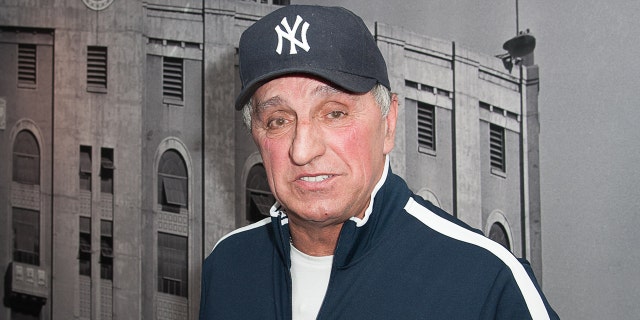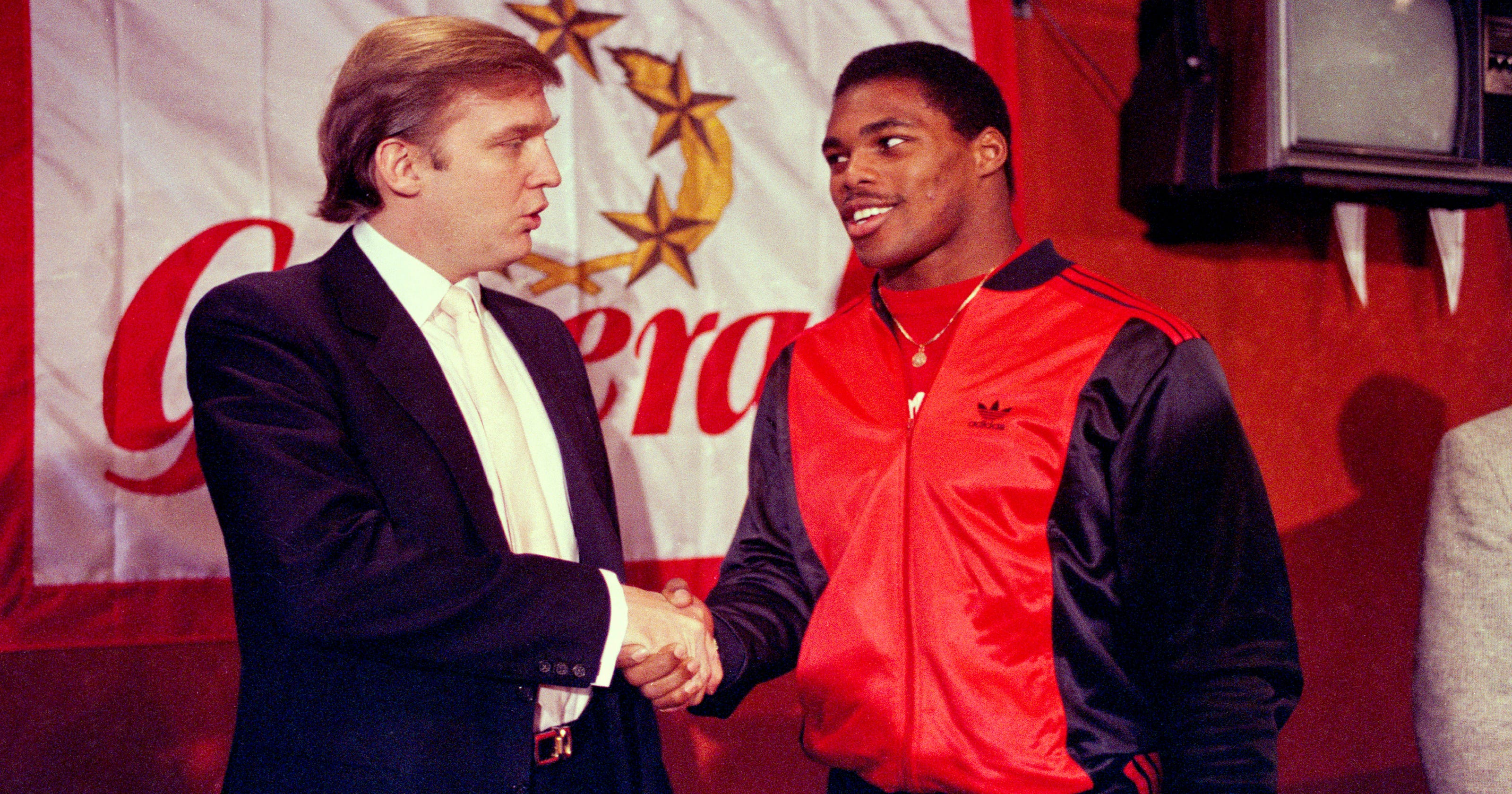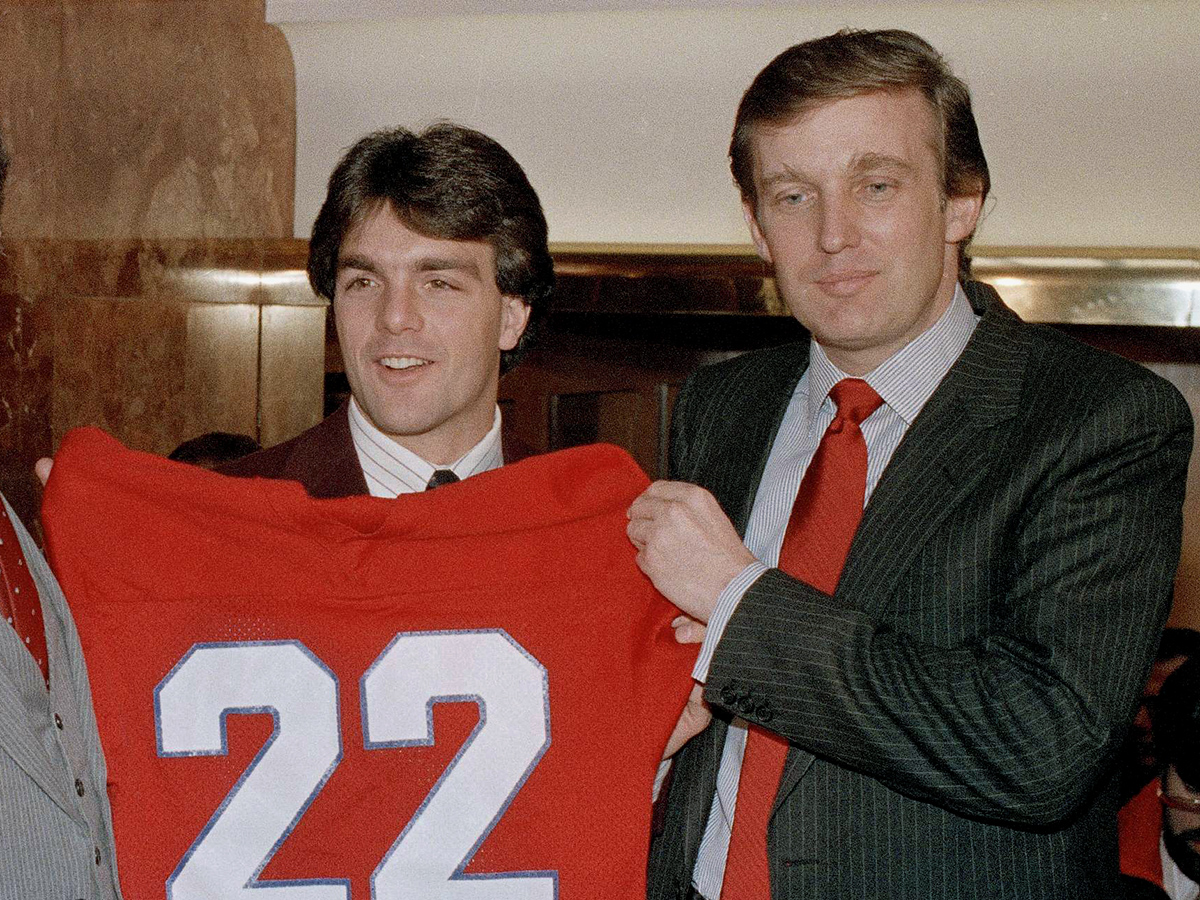I was excited. I was buzzing. I was jazzed.
I was monumentally disappointed.
Is it possible for a league to be made by one game? People who study the history of the NFL seem to think so: It was when Red Grange took his "Galloping Ghost" fame from the University of Illinois into the Polo Grounds in 1925 and sold it out, and, although his Chicago Bears beat the Giants that day, the gate receipts from a 70,000-seat sellout saved the Giant franchise, thus making football in the New York market viable, thus making professional football in America viable. (This probably also killed off the best chance professional soccer had to make it in America for half a century.)
by one game? From my perspective, it was. The Generals had signed the league's biggest coup, the sitting Heisman Trophy winner, Herschel Walker, lured out of his senior season at the University of Georgia and being a sure top pick in the 1984 NFL Draft by money and lots of it. But the Generals had no defense, and their 1st game, televised live on ABC, with the great college football voice Keith Jackson doing play-by-play, ended with the Los Angeles Express beating the Generals, 20-15, in front of just 32,008 fans, meaning the Coliseum had over 60,000 empty seats.
Other 1st-week games in the USFL: In the 1st game to be played, Tampa Bay beat Boston 21-17; Michigan beat Birmingham 9-7, Philadelphia beat Denver 13-6, Chicago beat Washington 28-7, and Oakland beat Arizona 24-0.
The Generals lost their 2nd game, too, losing 25-0 to the Stars at the Vet. They lost their 3rd game, their 1st home game at the Meadowlands (or, I was I was calling it then, "Generals Stadium"), 32-9 to the Bandits. They lost their 4th game, 31-21 to Boston at the Meadowlands.
As Stars coach Mora would later say when he was coaching the Indianapolis Colts, "Playoffs? Don't talk about Playoffs! You kidding me? Playoffs? I just hope we can win a game!"
Finally, the Generals went on a bit of a hot streak: They beat Arizona in Tempe, 35-21; then lost a home game to Michigan, 21-6, then got their 1st home win, 23-22 over a pathetic Washington squad; then lost in overtime in Chicago, 17-14; then beat Denver at Mile High, 34-29. Winning 3 out of 5 is good.
Then they lost their next 3, killing their momentum. They closed the season doing what a New York-area team should not do: They lost to a New England team, losing 34-10 in Boston. In the USFL's 18-game regular season, they finished 6-12, and didn't make the Playoffs.
Philadelphia won the Atlantic Division, Michigan the Central, Oakland (with a mere 9-9 record) the Pacific, and Chicago (tied for the Central lead but lost the tiebreaker) got the only Wild Card berth for the Playoffs. Philly beat Chicago at the Vet, Michigan beat Oakland in Pontiac, and in the USFL Championship Game, played on July 17, 1983, on neutral ground at Mile High in Denver, the Michigan Panthers, starring former University of Michigan receiver Anthony "The Darter" Carter, beat the Philadelphia Stars, 24-22.
Carter and the Panthers
*
The standard of play wasn't great, but it wasn't abject misery, as claimed by the media, which was in the pocket of the NFL. Don't forget: While ABC did the USFL's games, it also did
Monday Night Football, and thus had a vested interest in the NFL's dominance. Even so, it was the 3rd-largest network, and both CBS and NBC had it in their interest for the USFL to fail.
If a sportswriter wanted to be interviewed for his football knowledge on a major network, he had to treat the USFL like a minor league. And not like in soccer, where England's 2nd division (now oddly named "The Championship") is a standard not
that far below the 1st division ("The Premier League"), which would have been close to the USFL's actual performance level: The USFL was treated by the national media as if it was, truly, minor-league. And, as baseball pitcher turned sportscaster turned author Jim Bouton taught us, "The minor leagues are all very minor." (Though Bouton made an exception for Triple-A baseball's Hawaii Islanders.)
In management terms, the USFL was a colossal mess. The Denver Gold were a prime example: Red Miller feuded with management, so they fired him in midseason, and brought in his former Bronco quarterback, Craig Morton, who had just retired as a player, and had never coached before.
The L.A. Express were losing money left and right, and made a huge mistake the next season, signing Steve Young, the Brigham Young University quarterback who had nearly won the Heisman Trophy the year before, to an enormous contract, comparable in its excess to that of Alex Rodriguez, in its deferred payments to that of Bobby Bonilla, and in its results to that of Kevin Brown, who, lest we forget, was once considered good enough of a pitcher to get MLB's 1st contract worth a total over $100 million.
Steve Young, wondering if the money
he was promised was worth it
The USFL was also failing spectacularly at the box office. Leading the league in percent of stadium capacity filled were the Boston Breakers, with 61 percent -- but that meant they were getting 12,817 at Nickerson, which seated 21,000 at the time. Denver, which hadn't played to an unsold seat at a Bronco game since 1976 (and still hasn't, except for the Scab Year of 1987), had the highest average attendance, but even their 41,736 was only 56 percent. Tampa Bay had 39,896, but that was just 55 percent.
New Jersey (35,004), Oakland (31,211) and Arizona (25,776) also topped 25,000, but Birmingham's 22,046 was shockingly low for the football-mad State of Alabama, and L.A.'s 19,002 and Chicago's 18,133 were unacceptable for big markets. Even the teams that made it to the title game weren't packing 'em in: Michigan averaged 22,250, Philadelphia 18,650. These would have been unacceptable attendances even by the standards of 1983 baseball. Washington bottomed out at 13,850, in contrast to the Redskins, who hadn't played to an unsold seat since World War II.
Birmingham coach Dotsch, perhaps, said it best:
Every good coach has a game plan. In this case, the USFL got away from the game plan. There's no question we did, or I'll say the USFL did. I don't think we (meaning the Stallions) did, or Tampa Bay did. Hindsight is much better than foresight, I know, but things were done that hurt us. We didn't go crazy. We lost the fewest dollars of any USFL team. We were always the poorest team in the playoffs, but we held our own, and I'm proud of that. We did a good job with what we had. We won a lot more than we lost, and that's the biggest thing.Clearly, the smart thing for the USFL to do would have been to look at which markets were doing well, and which markets didn't have as much competition in other sports, and move the failing teams (even if they were playing well) to lesser-tapped markets for the Spring of 1984.
Clearly, the USFL did not do the smart thing.
They moved the Breakers from Boston to New Orleans, where the only major league team in place was the Saints, who stunk at the time, and didn't own the Superdome. (The State of Louisiana did, and still does.) That wasn't a bad move, and attendance did jump to 30,557.
John Walton, who quarterbacked in the Continental Football League,
the WFL, the NFL (Philadelphia) and the USFL (the Breakers).
But the league made a huge mistake in expanding from 12 to 18 teams. A tremendous sub-mistake was making one of the added teams the Pittsburgh Maulers, who signed Heisman winner Mike Rozier of Nebraska. Ed DeBartolo, owner of the NHL's Penguins, and father of 49ers owner Eddie DeBartolo, seemed like the right guy to own a Pittsburgh team in the USFL... if putting a USFL team in Pittsburgh had been the right thing to do.
It wasn't. It wasn't just that the Pittsburgh area had lost so many jobs, and with it so many people, who went elsewhere to look for work. It was that the Steelers owned that market. In Western Pennsylvania, here's how sports popularity went at the time: 1. Steelers; 2. Penn State; 3. Pirates; 4. University of Pittsburgh football; 5. Uh, do we still have a hockey team?
Giving the Maulers purple uniforms didn't help. And what's a "mauler," anyway? The helmet logo was a guy in a hard hat swinging a sledgehammer, suggesting a factory or mill worker. Right, remind the people of Western Pennsylvania of the jobs they'd been losing like crazy for the last 20 years.
Rozier, looking for a pass from Glenn Carano, while Jim Lohmann blocks.
You've never heard of Carano or Lohmann? That's not surprising.
The Maulers' 1st game saw them lose to Birmingham, whose quarterback was Cliff Stoudt, reviled as Terry Bradshaw's inadequate backup with the Steelers, and the locals at Three Rivers Stadium threw snowballs at him. Rozier, a native of Camden, New Jersey, did not have the same impact in the USFL as Walker, and his pro career was a disappointment (although not an outright bust, as he later did all right for the Houston Oilers). The Maulers finished tied with Washington for the league's worst record, 3-15.
Seeing the Southeast as underserved -- Texas and Florida had NFL teams, but the rest of the old Confederacy then had only Atlanta and New Orleans in the NFL -- and seeing how Birmingham was working out, the USFL expanded to include the Memphis Showboats and the Jacksonville Bulls, playing at the Liberty Bowl and the Gator Bowl, respectively.
Memphis was respectable mainly for one reason: Defensive end Reggie White, who played in the State at the University of Tennessee. They were coached by Franklin "Pepper" Rodgers, who'd done well at the stadium for Memphis State (now the University of Memphis). But Lindy Infante, already a respected NFL assistant, couldn't get much out of the Bulls.
Reggie White
The USFL also expanded into the Southwest. Putting a team in Dallas to compete with the Cowboys would have been lunacy, but the Oilers were awful at the time, so they put in the Houston Gamblers, coached by Jack Pardee, a former linebacker who'd been an All-American at Texas A&M and All-Pro with the Rams and Redskins, and had coached the Bears and Redskins to Playoff berths. The Gamblers signed University of Miami quarterback Jim Kelly, and won the Central Division.
Jim Kelly, apparently trying to invent an alternative to the huddle
Putting a team in San Antonio seemed to make sense, as the city had only the NBA's Spurs. But longtime Texas A&I (not A&M) coach Gil Steinke couldn't get the Gunslingers into gear. Putting a team in Oklahoma, where they could peel off Sooner fans, and fans who were a long way from Dallas and Kansas City, seemed to make sense, and hiring former Steeler defensive coordinator Woody Widenhofer as head coach and former Buccaneers quarterback Doug Williams were good moves. And the Oklahoma Outlaws had cool uniforms, black jerseys with a nasty-looking desperado on their helmets. But they went nowhere.
Doug Williams had Jimmie Giles in Tampa before this,
and Gary Clark and Ricky Sanders in Washington after this.
In Tulsa, he had... the other Mel Gray.
And in the oddest transaction in pro football history, the owners of the Chicago Blitz and the Arizona Wranglers traded their entire franchises. Including rosters, coaching staffs, and front office personnel. Where Chicago had been good and Arizona terrible in '83, the reverse was true in '84.
L.A. got Steve Young, and former San Diego Charger quarterback John Hadl as coach, and they won the Pacific Division. Philadelphia had the best record in the league at 16-2, edging New Jersey for the Atlantic Division title.
The Generals had been sold to Donald Trump, who brought in Walt Michaels, who'd coached the Jets to the AFC Championship Game in the '82 season, and former Cleveland Browns quarterback Brian Sipe, thus giving the Herschel-centric offense more diversity.
One of these men would later be treated for mental illness,
and the results are inconclusive. The other hasn't been treated
for mental illness, but became President.
(Supposedly, Trump originally wanted to lure Don Shula away from the Miami Dolphins, but balked when Shula wanted a free condo in the newly-opened Trump Tower. Somehow, I suspect, the older Trump would have accepted this, as the means to an end.)
The Generals lost to the Stars in the 1st round of the Playoffs, as former Penn State quarterback Chuck Fusina, running back Kelvin Bryant, and linebacker Sam Mills flattened Jersey's team. In the longest game in the history of professional football, one which went to a 3rd overtime (
Sports Illustrated's article on it was titled "It Was a Game and a Half"), Young led Los Angeles to dethrone defending champion Michigan, 27-21. Birmingham beat Tampa Bay, 36-17, and Arizona beat Houston, 17-16.
Kelvin Bryant. Like the Phillies, the Stars had uniforms
that really clashed with the horrid artificial turf at The Vet.
Unlike the Phillies and especially the Eagles, the uniforms
went great with the stadium's seat-color scheme.
In the Conference Championships, Arizona beat L.A., 35-23; and Philly beat Birmingham, 20-10. The title game was played at Tampa Stadium, and Philly beat Arizona, 23-3.
This is what a USFL Championship ring looks like.
*
Did the USFL learn from its '83 and '84 mistakes? Partly. The league was contracted to 14 teams. Chicago and Pittsburgh were out. Michigan and Oakland were merged, keeping the Oakland Invaders name. Oklahoma and Arizona were merged, becoming the Arizona Outlaws, with the colors somewhat merged and Oklahoma's logo kept.
There were moves. To take advantage of the fact that the Baltimore Colts had been moved to Indianapolis, the USFL should have moved the Washington Federals to Baltimore. Instead, they moved their most successful team, the Philadelphia Stars, down Interstate 95.
But a legal wrangle prevented them from moving to Memorial Stadium for 1985, so they went to Byrd Stadium at the University of Maryland, inside the Capital Beltway in College Park. So while they had the name "Baltimore Stars," they were a lot closer to Washington. This cut their per-game attendance in half, from 28,668 in '84 to a dismal 14,275 in '85.
The Federals
were moved, to Central Florida, an untapped market, to become the Orlando Renegades. Their coach was Lee Corso, a big name in the State, as he'd been Florida State's coach. Did this work out? As Corso would say in his later ESPN punditry career, "Not so fast, my friend!" The 'Gades finished 5-13, with an average attendance of 24,136. Each figure was better than they achieved in Washington, but still awful.
And the Breakers were moved again, to Oregon, where they became the Portland Breakers. True, Portland only had the NBA's Trail Blazers, but anybody who was an NFL fan in Oregon was either a Seattle Seahawks fan, or rooted for a faraway team like the Raiders, Steelers or Cowboys. And the L.A. Express crashed and burned: Their owners were bankrupt, and even with Young, they were just 3-15, with an average attendance of 8,415.
In the quarterfinals, Birmingham beat Houston 22-20, Memphis beat Denver 48-7, Oakland beat Tampa Bay 30-27, and Baltimore beat New Jersey 20-17 -- another Heisman winner, quarterback Doug Flutie, then considered "too short for the NFL," getting the Generals into the Playoffs, but no further.
One is a very small man. The other is a Heisman Trophy winner.
Alas, Flutie was a Republican, and continues to support Trump.
Trump was the first "Flutie Flake."
In the semifinals, Baltimore beat Birmingham 28-14, and Oakland beat Memphis 28-19. In the Championship Game, Baltimore (formerly Philadelphia) beat Oakland (sort of getting revenge on Michigan for the first title game), 28-24, at Giants Stadium.
The date was July 14, 1985. The USFL never played another game. Although this occurrence was suspected by many at the time, and knowing it would have surprised very few people, no one knew it for sure.
*
Later that year, the USFL announced that their challenge to the NFL was going to be full, starting in 1986: They were going to a Fall schedule, going head-to-head with the big boys. And they had sued the NFL on antitrust grounds. The USFL sought damages of $567 million, which, under antitrust law, would have been tripled to $1.7 billion if the jury found in their favor.
The USFL gave the NFL a chance to settle, proposing 2 remedies: Either force the NFL to negotiate new television contracts with only 2 networks, or force the NFL to split into two competing 14-team leagues, each limited to a contract with one major network.
Each NFL franchise was named as a co-defendant, with the exception of the Raiders, whose owner Al Davis was a major witness for the USFL, and had been excluded from the lawsuit in exchange for his testimony.
ABC announcer Howard Cosell was also a key witness for the USFL -- and this, more than his personality, his drinking, or his referring to Alvin Garrett of the Redskins, a black receiver, as "that little monkey" during a recent game, probably doomed him to being fired from Monday Night Football.
The lawyer for the USFL, Harvey Myerson, had what he felt were 3 "smoking guns":1. A memo from March 1973 to NFL broadcasting director Robert Cochran, from attorney Jay Moyer, stating that an "open network" might be open to the "invitation to formation of a new league."
2. A memo from August 1983 from Jack Donlan, NFL management council executive director, to his staff. The memo laid out plans for NFL teams to "increase salary offers to USFL to existing players or run the risk of losing them."
3. A memo from a Harvard University professor named Michael Porter, which included a plan to "Conquer" the United States Football League.
The case went to trial in the Spring of 1986, and lasted 42 days. On July 29, 1986, the jury handed down its verdict: They
declared the NFL a "duly adjudicated illegal monopoly," and found that the NFL had "willfully acquired and maintained monopoly status through predatory tactics." In other words, guilty as charged. However, the jury rejected the USFL's other claims. They found that the USFL had changed its strategy to a more risky goal of a merger with the NFL. Furthermore, the switch to an Autumn schedule caused the loss of several major markets. It has been established that Trump, as owner of the Generals, specifically wanted to force a merger, knowing that the majority of teams would be eliminated. Most importantly, the jury found that the NFL did not attempt to force the USFL off television. In essence, the jury felt that, while the USFL was harmed by the NFL's de facto monopolization of pro football in the United States, most of its problems were due to its own mismanagement. (In each of these cases, the emphasis is mine, not the jury's.)
The jury awarded the USFL only one dollar in nominal damages, which was tripled under antitrust law to three dollars. It later emerged that the jury incorrectly assumed that the judge could increase the award.
Almost immediately upon announcement of the verdict, the USFL accepted that it was a Pyhrric victory, and announced it was suspending operations for the 1986 season, with the intent of returning in 1987. Players signed to contracts were free to sign with NFL (or other professional) teams immediately.
The USFL was now some $160 million in debt. With nearly all of its players under contract to the NFL and the Canadian Football League, Commissioner Harry Usher announced the league would stay shuttered in 1987 as well. In 1990, now basically a shell of a corporation (if not a "shell corporation," a term with which Trump is well familiar), the USFL finally received a check for $3.76 in damages, the additional 76 cents representing interest earned while the ultimately failed appeal had continued. (Factoring inflation in, that's about $8.41 in 2022 money.)
* So what is the USFL's legacy? Actually, when you look at it, it could hardly be seen to have been a waste of time:
* Four players from the league made the Pro Football Hall of Fame: Steve Young went on to quarterback the 49ers to a title, Jim Kelly led the Buffalo Bills into 4 Super Bowls, Reggie White became a terror on defense for the Eagles and helped the Green Bay Packers win a Super Bowl, and Los Angeles Express offensive tackle Gary Zimmerman protected John Elway for 2 Bronco titles.
* The Redskins used some players who'd gotten their profiles raised in the USFL to win the title in the 1987 season. Oklahoma/Arizona's Doug Williams became the 1st black quarterback to play in, and the 1st to win, a Super Bowl, throwing passes to Jacksonville's Gary Clark and Houston's Ricky Sanders, and handing off to Philadelphia/Baltimore's Kelvin Bryant.
* Herschel Walker is not in Canton, but he should be: It's the
Pro Football Hall of Fame, not the
National Football League Hall of Fame. He gained 8,225 rushing yards and 4,859 receiving yards in the NFL, scoring 82 touchdowns. Put that together with his USFL stats, and that's 13,787 rushing yards, 6,843 receiving yards, and 143 touchdowns. Those are easily Hall-worthy numbers.
His NFL career is best remembered for the Cowboys trading him to the Minnesota Vikings for 5 players and 6 draft picks, which became a huge part of the Cowboys' quasi-dynasty of the 1990s. Herschel never won a ring, but he made the Playoffs with the Vikings, the Eagles and a return to the Cowboys, where he closed his career after the 1997 season. He also returned to the Meadowlands in 1995, with the Giants, but they didn't make the Playoffs that year. (The less said about his 2022 run for U.S. Senator from Georgia, the better.)
* Steve Spurrier moved on to Duke University, and revived their football program, giving them one of their few good periods, before going home to Gainesville and leading the University of Florida to glory.
* Doug Flutie was signed by the Chicago Bears after the USFL folded, but coach Mike Ditka didn't give him much of a shot. So he went to the CFL, and won Grey Cups with the Vancouver-based BC Lions, the Calgary Stampeders and the Toronto Argonauts.
Finally, the Bills gave him a shot, and, as Kelly's successor, he led them to the Playoffs. He would also do so with the San Diego Chargers, and closed his career in with his "hometown" Patriots (he grew up in Natick, on the opposite site of Boston from Foxborough, but was actually born outside Baltimore), backing up Tom Brady, and pulling off a trick that would have been in character for the USFL: On New Year's Day 2006, faking an extra point attempt as the holder, he dropped back and scored on a dropkick, something that hadn't been done, or even tried, in the NFL since 1941. That left...
* Sean Landeta as the last former USFL player still active. He'd been the Stars' punter, and won 2 Super Bowls with the Giants. He then bounced around, but reached the Playoffs with the Buccaneers, Packers, Eagles and Rams, before wrapping it up with the Giants in 2006, 21 years after the last USFL game.
* Houston's Jack Pardee and Darrel "Mouse" Davis (who took the Denver Gold reins in '85) both took the Gamblers' "run-and-shoot offense" elsewhere, Pardee racking up big scores as head man at the University of Houston, and Davis becoming the offensive coordinator of the Detroit Lions, helping them to what remains their last decent period.
* The USFL, like the 1960s AFL and the 1970s WFL, used the 2-point conversion. The NFL finally adopted it in 1994.







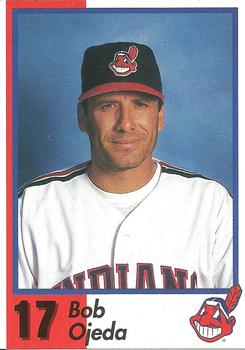



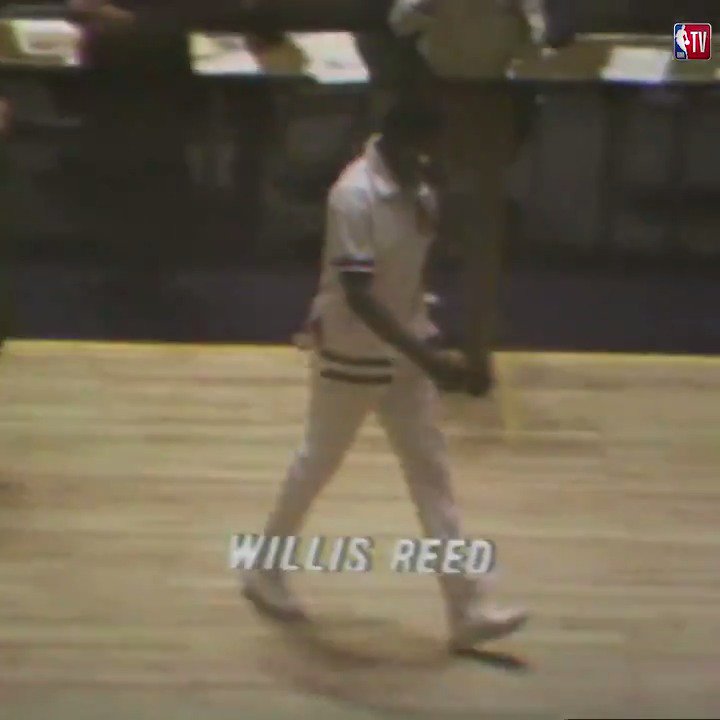


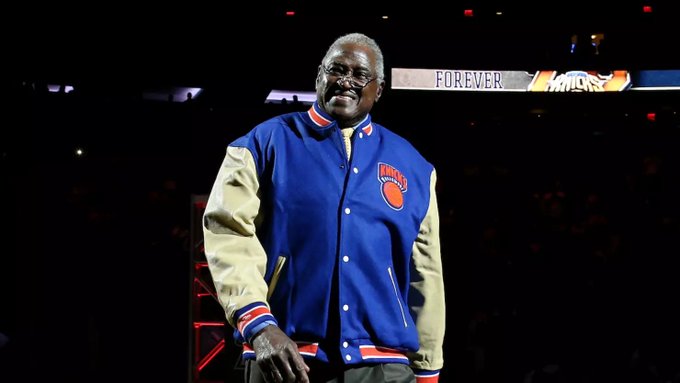



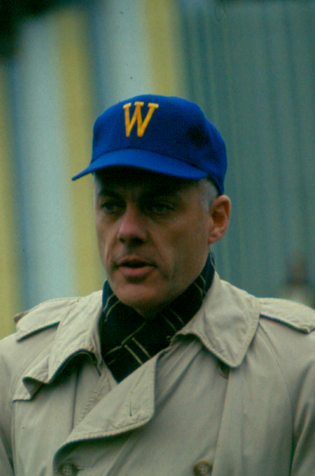
_(cropped).jpg)

